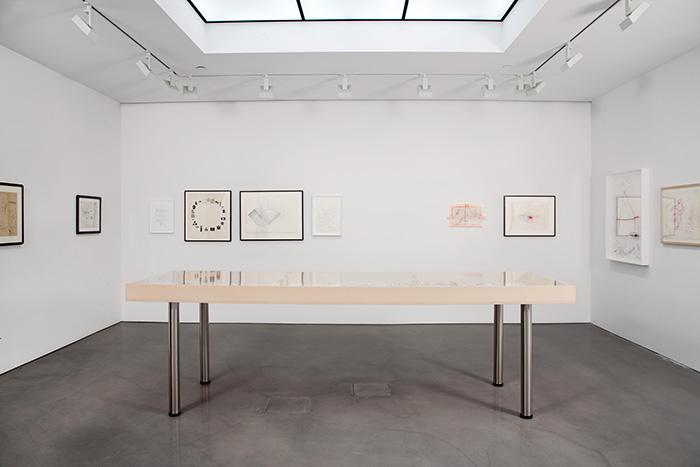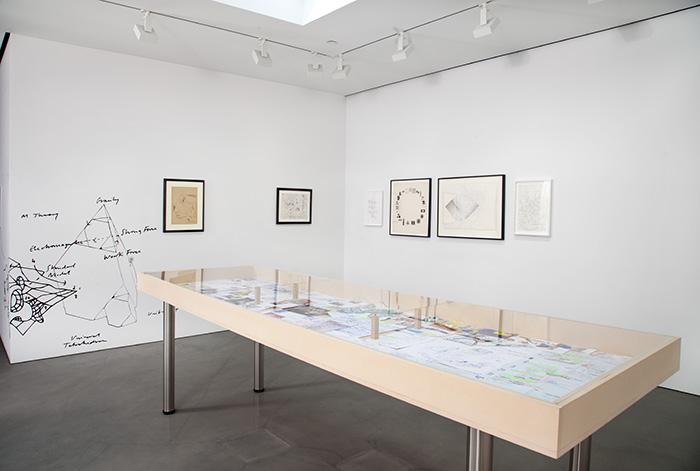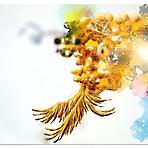The Temptation of the Diagram: Organized by Matthew Ritchie
March 30 – April 27, 2013
Gallery 2
Featuring: Aranda/Lasch, Archigram, Matthew Barney, Joseph Beuys, Earle Brown, Trisha Brown, Mel Bochner, John Bock, Lygia Clark, Max Ernst, Öyvind Fahlström, Thomas Hirschhorn, Steven Holl, Barry Le Va, Mark Lombardi, Thom Mayne, Julie Mehretu, Matt Mullican, Matthew Ritchie, Carolee Schneemann, Katy Schimert, Rudolf Steiner, Wolfgang Tillmans, and Bernar Venet
Andrea Rosen Gallery is pleased to announce The Temptation of the Diagram, a group show organized by Matthew Ritchie, at our new Gallery 2 location. Ritchie has been represented by the gallery for almost fifteen years, and we are thrilled to present his first curatorial endeavor at our space. The exhibition explores the diagram as an essential mode of artistic practice and expands on themes Ritchie researched and considered as an Artist in Residence at the Getty Research Institute in 2012 and currently at Columbia University.
Excerpt from the catalog essay by Matthew Ritchie
In Flaubert's 'The Temptation of St Anthony,' the tortured hermit, besieged by an encyclopedic parade of gorgeous visions, finally calls out: "Somewhere there must be primordial figures whose bodily forms are only symbols, could I but see them I would know the link between matter and thought; I would know in what Being consists!"
It is the last, impossible temptation.
As Susanne Leeb writes: "diagrams escape the insoluble dialectic of absence and presence which pervades the play of representation, yet…diagrams have no status in art per se." In art historical terms, the diagram is both refuge and refugee, a universal visual bridge between the written and the seen, but without a home in either.
This modest exhibition is not a history of the diagram but an organization of compelling examples of a specific kind of diagram, hand-made diagrams that occupy the impossible space between idea and reality. Perhaps they can somewhat counter the residual presumption that thinking runs counter to aesthetic contemplation; that intelligence is not beautiful. Perhaps we can see these diagrams as the artists do, central to their thinking about art-making. Diagrams are, as Leeb puts it "A tool for the making of relationships and for the abandonment of rational procedure." For the anchorite saint, this desire, "to assume all forms - penetrate each atom – be matter itself" is the final and irresistible temptation, the ultimate dream of the artist. Diagrams are the nervous systems of artists working with their skin off.
In the presence of diagrams, the profound questions of symbiosis between image and text, scale and distance, proximity and imagined immunity that define our use of any shared informational space are all too painfully evident.
That is not to suggest the diagram constitutes an easy escape route, or a trap door for the visionary. Although for artists it may be precisely the progress their work makes away from the original index of reality that constitutes its true 'sensual objecthood,' diagrams ultimately reference an operable (if imagined) dimensionality. Diagrams, seen and hidden, constitute the pivotal means for commutation between the multitudinous spaces of prediction, memory, fantasy, language, metaphor and instruction.
If all this seems romantic, it is. The diagram is a trace of our collective efforts to articulate and negotiate an almost impossible circumstance: reality itself.
Imagine a single dimension, a point. Add a line. Now add an arrow to the line, a vector. Can you imagine another dimension? Go ahead. Add another line, another and another. Now add arrows to all those lines. More! Are they all going in the same direction? Impossible!
Are we there yet?
"The movement is everything, the final goal nothing."
Eduard Bernstein.
Matthew Ritchie's installations, which integrate painting, wall drawings, light boxes, performance, sculpture, and projections, are investigations of the idea of information explored through science, architecture, history and the dynamics of culture, defined equally by their range and their lyrical visual language. In 2001, Time magazine listed Ritchie as one of 100 innovators for the new millennium, for exploring "the unthinkable or the not-yet-thought." His work has been shown in numerous exhibitions worldwide, including the Whitney Biennial, the Sydney Biennial, the Sao Paulo Biennial, the Venice Architecture Biennale, the Seville Biennale, and the Havana Biennale, and is in the collections of the Museum of Modern Art, the Guggenheim Museum, the Whitney Museum of American Art, the Albright-Knox Museum, the San Francisco Museum of Modern Art and other institutions worldwide, including a permanent large-scale installation at MIT. He has written for Artforum, Flash Art, Art & Text, and the Contemporary Arts Journal, and is a contributor to Edge. In 2012 Ritchie was Artist in Residence at the Getty Research Institute, Los Angeles.
Ritchie is currently Mellon Artist in Residence and Adjunct Professor in the Graduate Visual Arts Program at Columbia University, New York, where he has organized two public workshops this spring to examine how we can extend understanding and use of our new, current dimension – where every image in history can be seen at once, every idea can be communicated, rebutted and digitally reformatted, and every space can host any form of presence – in the shared space of culture. The next workshop, Art, Information and Networks, will feature Albert-László Barabási and Caroline Jones, moderated by Matthew Ritchie, on April 19 at 6 PM at Columbia University. It is free and open to the public; for more information, visit arts.columbia.edu. Ritchie will also take part in Rhizome's Seven on Seven conference in April.
About Gallery 2
Andrea Rosen conceived Gallery 2 in 1999 as a liberating arena in which to consider new ideas and create parallel perspectives to the Gallery's primary program, and as a means of fulfilling the Gallery's responsibility to broaden visual references and education for its audience. An inspiring and highly important part of the Gallery's exhibition program, Gallery 2 was formerly located adjacent to the main gallery at the 525 West 24th Street location, prior to the recent opening of separate Gallery 2 space at 544 West 24th Street. Gallery 2 has developed a reputation for significant historical exhibitions, presenting first-time, one-person shows, and shedding light on lesser known aspects of prominent artists' practices. Many of the shows conceived in Gallery 2 have gone on to have other lives in other exhibitions and institutions. The program affords the Gallery the opportunity to work with young artists who might not otherwise not have the opportunity to show within the primary space as well as esteemed independent curators and art historians. Andrea Rosen Gallery has been built on the ideals of what it means to represent a specific group of artists over a very long period of time, but it has also come to realize that infusing the gallery with one-time projects enhances the vocabulary, meaning, and impact of the gallery's agenda.
For press inquiries, please contact Jessica Eckert at j.eckert@rosengallery.com or Michelle Finocchi at michelle@michellefinocchi.com
Matthew Ritchie
Published in conjunction with the project Matthew Ritchie: Remanence, an interdisciplinary 18-month artist residency from 2013 to 2014, organized by Jenelle Porter, Mannion Family Senior Curator, with John Andress, Associate Director of Performing Arts, and Gabrielle Wyrick, Associate Director of Education.
Matthew Ritchie: More Than The Eye
Acclaimed in the art world for his room-size installations of paintings, sculpture, and digital projections, Matthew Ritchie’s work investigates architecture and the dynamics of culture. Named by Time magazine in 2001 as one of 100 innovators for the new millennium, his rich work draws from subjects as diverse as ancient myth and medieval alchemy to cutting-edge physics and contemporary politics. This artist-designed book will explore Ritchie’s large-scale artistic "interventions" in buildings designed by Morphosis among others, including the Guggenheim Museum and MIT.
Publisher: Rizzoli (November 25, 2008)
ISBN-10: 0847831086
ISBN-13: 978-0847831081
Matthew Ritchie: The Morning Line
Published by Moderne Kunst Nürnberg
Edited Eva Ebersberger, Daniela Zyman. Preface by Francesca von Habsburg.
Text by Benjamin Aranda, Brandon LaBelle, Helene Furján, Chris Lasch, Tony Myatt, Hans Ulrich Obrist, Matthew Ritchie, Roland Schöny, Mark Wasiuta.
Situated at the interaction of art, architecture, music, mathematics, cosmology and science, Matthew Ritchie's "The Morning Line" is a 33-foot high sound pavilion, constructed in aluminum and conceived in part as a successor to Edgard Varèse and Le Corbusier's pavilion for the 1958 World's Fair, and Fritz Bornemann's Expo '70 Pavilion. Designed in collaboration with New York-based architects Aranda Lasch, the Arup Advanced Geometry Unit and the Music Research Centre of York University, the structure was inspired by the cosmological theories of Paul Steinhardt and Neil Turok, and offered a sonic environment in which newly commissioned works by well-known musicians were performed. This survey of the project includes a book containing Todd Eberle's photographs of the structure, a poster, a newspaper and a red vinyl LP with music by contemporary electronica musicians such as Alexej Borisov, Tommi Grönlund, Petteri Nisunen, Christian Fennesz, Carsten Nicolai, Zsolt Olejnik, Finnbogi Petursson, Franz Pomassl, Terre Thaemlitz and Zavoloka.
Publisher: Moderne Kunst Nürnberg; Box edition (April 30, 2012)
ISBN-10: 3869842423
ISBN-13: 978-3869842424
The Morning Line
Edited by Eva Ebersberger, Daniela Zyman.
Text by Caroline A. Jones, Peter Weibel, Benjamin Aranda, Chris Lasch, Mark Wasiuta, Bryce Dessner, Florian Hecker, Tony Myatt.
Extensive documentation of the worlds first traveling semasiographic structure; a collaborative environment conceived by Matthew Ritchie and designed with architects Aranda/Lasch, musician Bryce Dessner and scientist Paul Steinhardt.
Publisher: Walther Konig (February 1, 2009)
ISBN-10: 3865605664
ISBN-13: 978-3865605665
Matthew Ritchie: Proposition Player
In 1995, British artist Matthew Ritchie embarked on an extraordinary undertaking: he set out to tell the story of everything, from the Big Bang onward. His tale was to be told in paintings and drawings through a core group of 49 characters drawn from sources as diverse as mythology, quantum physics, alchemy, gambling, biblical tales, and pulp fiction. With Proposition Player, Ritchie's first major solo museum exhibition and accompanying catalogue, his narrative has reached a "climax, collapse, and crisis"--the story has morphed into a game and Ritchie has created a veritable information casino. Accompanying the paintings and drawings for which the artist is internationally known are works in new media, including a 100-foot-long three-dimensional drawing, an interactive craps table with digital animation that invites viewers to roll the dice for the future of the universe, an enormous rubble floor mosaic that invites viewers to walk into the heart of the piece, and a deck of cards featuring Ritchie's cast of characters.
Publisher: Contemporary Arts Museum (January 31, 2004)
ISBN-10: 0936080841
ISBN-13: 978-0936080840
Matthew Ritchie: Incomplete Projects 01-07
Matthew Ritchie: Incomplete Projects 01-07 was originally published from 2000 to 2006 as seven separate volumes to record a diverse group of projects. Institutional acknowledgements and credits accompanied each volume. Half of each print run was preserved to be collected in this final edition.
Awards: Best of Category in Graphic Design, I.D. Magazine, 2007
Hardcover: 224 pages
Publisher: Wild Card Crew, in collaboration with the Museum of Contemporary Art, North Miami; Dallas Museum of Art; Artists Space; MIT; Parkett; Two Palms Press; and Portikus
Matthew Ritchie: Incomplete Projects 07
Catalogue published in conjunction with the exhibition "We Want to See Some Light," July 9 - August 21, 2005, at Portikus im Leinwandhaus, Frankfurt am Main. It is the seventh volume in a multi-part series titled Matthew Ritchie, Incomplete Projects.
Matthew Ritchie: Incomplete Projects 06
Published in conjunction with Two Palms Press, 2004. It is the sixth volume in a multi-part series titled Matthew Ritchie, Incomplete Projects.
Matthew Ritchie: Incomplete Projects 05
Catalogue published in conjunction with the permanent installation Games of Chance and Skill (2002), commissioned by the MIT Perecent for Art Program for the Albert and Barrie Zesiger Sports and Fitness Center on the Massachusetts Institute of Technology campus in Cambridge, Massachusetts. It is the fifth volume in a multi-part series titled Matthew Ritchie, Incomplete Projects.
Matthew Ritchie: Incomplete Projects 04
Catalogue published in conjunction with the Edition for Parkett 61, November 5, 2001:
MATTHEW RITCHIE
The Bad Need
2001
adhesive-backed vinyl and acrylic paint
36 x 41 inches (92.08 x 105.41 cm)
Edition of XVIII
Accompanied by a certificate of authenticity in the form of a signed and numbered artist's book.
Matthew Ritchie: Incomplete Projects 03
Catalogue published in conjunction with the Edition for Artists Space:
MATTHEW RITCHIE
Sea State One
2001
Four color hand printed, pigminted relief print on Somerset paper.
16 x 32 inches
(40.6 x 81.3 cm)
Edition of 70
Published by Two Palms Press
Accompanied by one copy of the artist's book Sea State One: Incomplete Projects 03, containing manipulated images from The New Place, 2001, commissioned for "010101: Art in Technological Times," by the San Francisco Museum of Modern Art, CA.
Matthew Ritchie: Incomplete Projects 02
Catalogue published for the exhibition "Concentrations 38: Matthew Ritchie," organized by the Dallas Museum of Art, and curated by Suzanne Weaver, January 23 - April 21, 2001. It is the second volume in a multi-part series titled Matthew Ritchie, Incomplete Projects.
Matthew Ritchie: Incomplete Projects 01
Catalogue published for the exhibition "Matthew Ritchie," organized by the Museum of Contemporary Art, North Miami, and curated by Bonnie Clearwater, March 31 - June 25, 2000. It is the first volume in a multi-part series titled Matthew Ritchie, Incomplete Projects.
The Father Costume
Behold a stunning world, composed largely of water, where clothing changes people's behavior and time itself can be worn and discarded like cloth. Witness a father who takes his two boys out to sea, in flight from some menace at home, thus launching their adventures in a strange and dangerous territory. Artist Matthew Ritchie's striking images blend scientific diagramming with vivid, colorful renderings of the apocalypse, while writer Ben Marcus's cold prose plumbs the inner workings of two boys caught out at sea with a father whose costumes grow increasingly menacing. In this collaborative work, Ritchie's and Marcus's shared obsessions of mythology, physics and ancient texts have produced a conjunction of text and image in which people themselves are merely costumes for the darker needs that drive them.
Published by Artspace Books
Hardcover, 6.25 x 8.25 in. / 90 pgs / 16 color
Publication date 5/2/2002
ISBN 9781891273032
Matthew Ritchie: The Big Story
Published on the occassion of the exhibition "Mythopoeia: Projects by Matthew Barney, Luca Buvoli and Matthew Ritchie," curated by Jill Snyder. Presented at the Cleveland Center for Contemporary Art, Cleveland, Ohio, February 12 - May 2, 1999.
Matthew Ritchie: Hard Way
Published in 1996 by Galerie Météo, Paris, Basilico Fine Arts, New York, and C/O - Atle Gerhardsen, Oslo




















